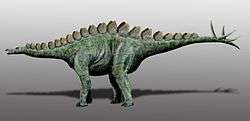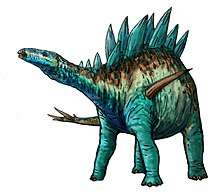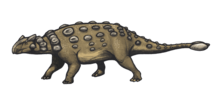Miragaia longicollum
Miragaia (named after Miragaia, the parish in Portugal and geologic unit where its remains were found) is a long-necked stegosaurid dinosaur. Its fossils have been found in Upper Jurassic rocks in Portugal. Miragaia has the longest neck known for any stegosaurian, which included at least seventeen vertebrae.
| Miragaia longicollum | |
|---|---|
.jpg) | |
| Skeleton model | |
| Scientific classification | |
| Kingdom: | Animalia |
| Phylum: | Chordata |
| Clade: | Dinosauria |
| Order: | †Ornithischia |
| Suborder: | †Stegosauria |
| Family: | †Stegosauridae |
| Subfamily: | †Dacentrurinae |
| Genus: | †Miragaia Mateus et al., 2009 |
| Species: | †M. longicollum |
| Binomial name | |
| †Miragaia longicollum Mateus et al., 2009 | |
Discovery

Miragaia is based on holotype ML 433, a nearly complete anterior half of a skeleton with partial skull (the first cranial material for a European stegosaurid).[1] The remains were found after the construction of a road between the villages of Miragaia and Sobral. The rear half of the skeleton was probably destroyed by the roadcut. The fossils were dug up in August 1999 and August 2001.[2] Among the recovered bones were most of the snout, a right postorbital, both angulars of the lower jaws, fifteen neck vertebrae (the first two, which articulated with the skull, were absent), two anterior dorsal vertebrae, twelve ribs, a chevron, the shoulder bones, most of the forelimbs including a possible os carpi intermedium, a right first metacarpal and three first phalanges; and thirteen bony plates plus a spike.[1] The bones were not articulated but dispersed over a surface of about five to seven metres, though there was a partial concentration of fossils that could be salvaged within a single block.[2] ML 433 was found in the Miragaia Unit of the Sobral Unit, Lourinhã Formation, which dates to the late Kimmeridgian-early Tithonian (Late Jurassic, approximately 150 million years ago).[1]
Octávio Mateus, Susannah Maidment and Nicolai Christiansen named and briefly described Miragaia in 2009. The type species is Miragaia longicollum. The generic name refers to the village of Miragaia but also is an allusion to mira, "wonderful" in Latin, and Gaia, the Earth Goddess. The specific name means "long neck" from the Latin longus, "long" and collum, "neck". A partial pelvis (ilium and pubic bone) and two partial dorsal vertebrae from a juvenile individual (specimen ML 433-A) were found at the same location, intermingled with the bones of the holotype, and were also assigned, as a paratype, to M. longicollum.[1]
Casts were made of the holotype bones and partially based on these a life-size skeletal model was constructed from polyurethane and polyester resin parts.[2]
In 2010, Alberto Cobos et al. noted that all the diagnostic characters of Miragaia longicollum are based on skeletal elements that are absent in the Dacentrurus holotype found in England in layers of about the same age, while all traits that can be compared are shared by both genera. Cobos et al. therefore proposed that Miragaia is a junior synonym of Dacentrurus, meaning that it is the same dinosaur, because it is not possible to differentiate the two taxa through their holotypes.[3]
However, Francisco Costa and Mateus in 2019 affirmed the validity of Miragaia longicollum, describing a newly recognised specimen, MG 4863, that had already been excavated in 1959 by Georges Zbyszewski but was only prepared between 2015 and 2017. It consists of a skeleton that also contains tail vertebrae, the most complete dinosaur ever found in Portugal. They renamed Alcovasaurus into a second species: Miragaia longispinus.[4]
Description
Size and diagnosis

The total length of Miragaia has been estimated at 5.5 – 6 metres (18–20 ft).[5] In 2010, Gregory S. Paul estimated the length at 6.5 metres, the weight at two tonnes.[6] Histology shows that the holotype specimen was about 21 years old.[7]
The describers established six distinguishing traits. At their very midline, the praemaxillae meet in a small sharp point, set within a larger notch in the snout tip as a whole. The front lower side edge of the praemaxilla protrudes to below. At least seventeen cervical vertebrae are present. The neural spines of the middle cervical vertebrae have a notch at their lower front edge with immediately above it a process directed to the front. The vertebrae of the middle neck, rear neck and front back possess neural spines that have a transversely expanded upper end. On the neck two rows of triangular bony plates are present that have a lightly convex outer side and a notch at the upper front edge creating a hook.[1]
Neck elongation

The most notable feature of Miragaia is its long neck, which was composed of at least seventeen vertebrae. According to the authors, this represents the culmination of a trend towards longer necks seen in stegosaurians. The Thyreophora, the larger group they belong to, originally seem to have had nine neck vertebrae and this is also the number shown by the basal stegosaurian Huayangosaurus. Later forms like Stegosaurus or Hesperosaurus had twelve or thirteen. Remarkably Miragaia had more neck vertebrae than most sauropods, a different group of dinosaurs famous for their long necks, which contrasts with the traditional view of stegosaurians as low browsers with short necks. Only the Chinese sauropods Euhelopus, Mamenchisaurus and Omeisaurus had as many neck vertebrae as Miragaia, with most sauropods of the Late Jurassic possessing only twelve to fifteen. Mateus and colleagues suggested that the long neck either allowed Miragaia to browse at a level that other herbivores were not exploiting, or that the neck arose due to sexual selection. The possible food gathering function of the neck makes sexual selection a less plausible explanation, but is not in itself entirely convincing: though the contemporary Iberian sauropods Lusotitan, Dinheirosaurus and Turiasaurus were all very large and might not have competed with a medium-height browser, the niche partitioning is still problematic because in Iberia stegosaurian remains have been referred to Dacentrurus and Stegosaurus, which would have possessed a feeding envelope or feeding height stratification overlapping that of Miragaia.[1]
In sauropods, great neck length was achieved by a combination of three processes: incorporation of back vertebrae into the neck; addition of new vertebrae; and lengthening of the individual neck vertebrae. The authors considered whether these mechanisms might have been paralleled in stegosaurians. The long neck of Miragaia appears to have resulted mostly from back vertebrae becoming incorporated into the neck, based on vertebral counts of other stegosaurians. In this group the total number of prescral vertebrae, of the back and neck combined, hardly increased, but there is a clear transformation, dorsal vertebrae of the back becoming "cervicalised" into cervical vertebrae of the neck. Whereas Huayangosaurus still possessed sixteen back vertebrae, this number was reduced to thirteen in Hesperosaurus. There is currently — no count of the number of dorsal vertebrae being possible — no evidence that with Miragaia new vertebrae contributed to the neck; instead, the distribution of existing vertebrae in the back and neck probably changed, about four extra vertebrae becoming cervicals. There is some evidence for increasing vertebral length in Miragaia and Stegosaurus, compared to more basal species, but this is equivocal and could be due to post-mortem distortion; this mechanism was seen as a minor factor in neck elongation.[1]
The authors also discussed the possible underlying genetic mechanisms for such changes. They pointed out that, in contrast with mammals which almost always have seven neck vertebrae due to as much as four hox-genes ensuring a strict partitioning between neck and back, in extant dinosaurs such as the chicken only a single hox-gene regulates this process, seemingly leading to greater evolutionary plasticity.[1]
Skeleton

Apart from the neck length, the known osteology of Miragaia resembles that of other stegosaurids, differing in small details. The tip of the beak was toothless, as in Stegosaurus. The upper beak, formed by the praemaxilla, was pendant. The notch in the snout tip was, seen from above, shaped like a W, whereas in Stegosaurus the notch is U-shaped, with a little bulbous projection in the middle. The upper surface of the nasal bone was ornamented. A ridge formed the contact with the maxilla. The maxilla had sixteen teeth. The postorbital was a small and triradiate element.[1]
The cervical vertebrae had well-developed cervical ribs, fused to the vertebral body. The ribs were elongated, with a forward-pointing process on the capitulum, the main rib head. The neural spines of the rear cervicals and front dorsals are transversely expanded at their upper ends due to rugosities serving as an attachment for tendons. This expanded sector projects to the front also, creating a notch on the lower front edge. Additionally the neural spine base is transversely constricted. Ridges extend to the rear from the sides of the neural spine base, over the upper sides of the rear joint processes, the postzygapophyses. These postzygapophyses themselves project far beyond the rear facet of the vertebral body, a derived trait. The prezygapophyses to the contrary, are much shorter; they have a notch at the front upper edge.[1]
The scapula had a large rectangular acromion, with a sharp upper corner, on the lower front edge. The more narrow coracoid had a rounded lower edge. Both the upper arm and ulna and radius (lower arm bones) are also comparable to those of Stegosaurus. The tuberosity of the rear humerus serving as attachment for the musculus triceps brachii is well-developed but the vertical ridge running from it to below is not. In the pelvis, the pubic bone had a deep front part, the processus praepubicus, with a little upward projecting process as seen in Dacentrurus; the rear shaft had a lightly expanded tip.
Osteoderms
Miragaia, like all known stegosaurians, showed an array of plates and spikes, consisting of skin ossifications or osteoderms. Paired triangular plates ran down the midline of the neck, reconstructed as eight pairs. They were asymmetrical with a convex outer side and a concave inner side. Their bases were not very expanded with the exception of a possible last pair, located on the front back. They were obtuse but lightly hooked at the front.[1] A rather long, narrow and straight preserved spike was at first considered to have been a shoulder spine, but was later seen as part of some tail arrangement.
Phylogeny
Miragaia was placed in the Stegosauridae in 2009. Mateus and colleagues performed a phylogenetic analysis and found Miragaia to group with Dacentrurus in a clade Dacentrurinae, newly named for the occasion, the sister group to Stegosaurus (the latter genus was in the cladistic analysis considered to include Hesperosaurus and Wuerhosaurus).[1]
The position of Miragaia in the stegosaurid evolutionary tree is shown by this cladogram:[1]
| Stegosauridae |
| ||||||||||||||||||||||||||||||||||||
The authors stressed that the only synapomorphy, shared derived trait, supporting the Dacentrurus-Stegosaurus clade was the possession of the long cervical postzygapophyses, and that these are in fact unknown for Dacentrurus itself, so that its close position to Stegosaurus was merely based on the new data provided by the description of Miragaia.[1]
References
- Mateus, Octávio; Maidment, Susannah C.R.; Christiansen, Nicolai A. (2009-05-22). "A new long-necked 'sauropod-mimic' stegosaur and the evolution of the plated dinosaurs". Proceedings of the Royal Society B: Biological Sciences. The Royal Society. 276 (1663): 1815–1821. doi:10.1098/rspb.2008.1909. PMC 2674496. PMID 19324778.
- Araújo, Ricardo; Mateus, Octávio; Walen, Aart; Christiansen, Nicolai (January 2009). "Preparation techniques applied to a stegosaurian dinosaur from Portugal" (PDF). Journal of Paleontological Techniques. 5: 1–23.
- Cobos, Alberto; Royo-Torres, Rafael; Luque, Luis; Alcalá, Luis; Mampel, Luis (July 2010). "An Iberian stegosaurs paradise: The Villar del Arzobispo Formation (Tithonian–Berriasian) in Teruel (Spain)". Palaeogeography, Palaeoclimatology, Palaeoecology. 293 (1–2): 223–36. Bibcode:2010PPP...293..223C. doi:10.1016/j.palaeo.2010.05.024.
- Costa, Francisco; Mateus, Octávio (13 November 2019). "Dacentrurine stegosaurs (Dinosauria): A new specimen of Miragaia longicollum from the Late Jurassic of Portugal resolves taxonomical validity and shows the occurrence of the clade in North America". PLOS ONE. 14 (11): e0224263. doi:10.1371/journal.pone.0224263.
- Mike (25 February 2009). "New Long-Necked Stegosaurs Discovered". Everything Dinosaur Blog. Archived from the original on 13 June 2018.
- Paul, Gregory S. (2010). The Princeton Field Guide to Dinosaurs. Princeton University Press. p. 223. ISBN 978-0-691-13720-9.
- Waskow, Katja; Mateus, Octávio (April 2017). "Dorsal rib histology of dinosaurs and a crocodylomorph from western Portugal: Skeletochronological implications on age determination and life history traits" (PDF). Comptes Rendus Palévol. 16 (4): 425–39. doi:10.1016/j.crpv.2017.01.003.

